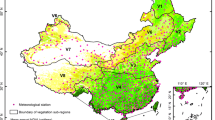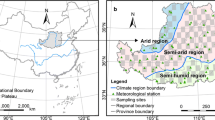Abstract
According to the concept of ecoclimatic factor’s guarantee rate, this study purposes to quantitatively analyze the interdecadal changes of the four major vegetation transition zones in Northeast China based on the warmth index first developed by Kira and the humidity index put forward by Xu during the period 1961–2007. On this basis, the responses of the interdecadal changes of vegetation transition zones to climate were analyzed. The results indicated that latitudinal vegetation transition zones had been moving laggingly to higher latitude (shifting upwards in altitude) and that longitudinal vegetation transition zones had been shifting slowly toward humid area in the whole sequence, whereas the shifts were fluctuant in stages. The changes of vegetation transition zones of Northeast China expressed in distribution and bandwidth responded to climate change, not only in the whole sequence but also in stages.




Similar content being viewed by others
References
Agricultural Meteorology, Shenyang Agricultural University (1982) Agroclimatology. Mimeograph (in Chinese). Shenyang Agricultural University, Shenyang
Brown JH, Davidson DW, Munger JC et al (1986) Experimental community ecology: The desert granivore system. In: Diamond J, Case TJ (eds) community ecology. Harper and Row, New York, pp 41–62
Budyko MI (1974) Climate and life. Academic, New York
Camill P, Clark JS (2000) Long-term perspectives on lagged ecosystem response to climate change: permafrost in boreal peatlands and the grassland/woodland boundary. Ecosystems 3:534–544
Cannone N, Sgorbati S, Guglielmin M (2007) Unexpected impacts of climate change on alpine vegetation. Front Ecol Environ 5(7):360–364
Chapin FS, Starfield AM (1997) Time lags and novel ecosystems in response to transient climatic change in arctic Alaska. Clim Change 35:449–461
Chang Y, Bu RC, Hu YM (2002) A review on landscape boundary studies. Chin J Ecol 21(5):49–53, in Chinese with English abstract
Clark JS, Grimm EC, Lynch J et al (2001) Effects of Holocene climate change on the C4 grassland/woodland boundary in the Northern Plains, USA. Ecology 82(3):620–636
Dale VH, Joyce LA, McNulty S et al (2000) The interplay between climate change, forests, and disturbances. Sci Total Environ 262:201–204
Dale VH, Joyce LA, McNulty S et al (2001) Climate change and forest disturbances. Bioscience 51(9):723–734
Easterling DR, Meehl GA, Parmesan C et al (2000) Climate extremes: observations, modeling, and impacts. Science 289:2068–2074
Fllner S, Shmida A (1981) Why are adaptations for long range seed dispersal rare in desert plants? Oecologia 51:133–144
Fang JY, Yoda K (1989) Climate and vegetation in China. II. Distribution of main vegetation types and thermal climate. Ecol Res 4:71–83
Fang JY, Yoda K (1990) Climate and vegetation in China. IV. Distribution of tree species along the thermal gradient. Ecol Res 5:291–302
Gonzalez P, Neilson RP, Drapek RJ (2005) Climate change vegetation shifts across global ecoregions. Ecol Soc Am Annu Meet Abstr 90:228
Grabherr G, Gottfried M, Pauli H (1994) Climate effects on mountain plants. Nature 369:448
Guo ZX, Wang ZM, Son KS et al (2008) Changes of vegetation coverage in Northeast China from 1982 to 2003. Acta Bot Boreal Occident Sin 28(1):155–163, in Chinese with English abstract
Guo ZX, Zhang XN, Wang ZM et al (2010) Simulation and variation pattern of vegetation phenology in Northeast China based on remote sensing. Chin J Ecol 29(1):165–172, in Chinese with English abstract
Halpin PN (1997) Global climate change and natural-area protection: management responses and research directions. Ecol Appl 7:828–843
Heijmans MMPD, Mauquoy D, vanGeel B et al (2008) Long-term effects of climate change on vegetation and carbon dynamics in peat bogs. J Veg Sci 19:307–320
Hughes L (2000) Biological consequences of global warming: is the signal already apparent? Trends Ecol Evol 15(2):56–61
Holdridge LR (1947) Determination of world plant formations from simple climatic data. Science 105:367–368
Houghton JT, Jenkins GJ, Ephraums JJ (1990) Climate change: the IPCC scientific assessment. Cambridge University Press, Cambridge
Kira T (1991) Forest ecosystems of East and Southeast Asia in global perspective. Ecol Res 6:185–200
Kullman L (2002) Rapid recent range-margin rise of tree and shrub species in the Swedish Scandes. J Ecol 90:68–77
Lenihan JM, Drapek R, Bachelet D et al (2003) Climate change effects on vegetation distribution, carbon, and fire in California. Ecol Appl 13(6):1667–1681
Markham A (1996) Potential impacts of climate change on ecosystems: a review of implications for policymakers and conservation biologists. Clim Res 6:179–191
Masek JG (2001) Stability of boreal forest stands during recent climate change: evidence from Landsat satellite imagery. J Biogeogr 28:967–976
McCarty JP (2001) Ecological consequences of recent climate change. Conserv Biol 15(2):320–331
McCulloch JSG (1965) Table for the rapid computation of the Penman estimate of evaporation. E Afr Agric For J 1:286–295
Ni J (1998) Indexes of vegetation–climate classification and its applications. Chin J Ecol 17(2):33–44, in Chinese with English abstract
Penman HL (1956) Estimating evaporation. Trans Am Geophys Union 37(1):43–50
Ren ME, Yang JZ (1961) The problems of the physical regionalization of China. Acta Geographica Sinica 27:66–74, in Chinese
Ritchie JC (1986) Climate change and vegetation response. Plant Ecol 67:65–74
Rosenzweig C, Parry ML (1994) Potential impact of climate change on world food supply. Nature 367:133–13
Sala OE, Chapin FS, Armesto JJ et al (2000) Global biodiversity scenarios for the year 2100. Science 287:1770–1774
Thornthwaite CW (1948) An approach toward a rational classification of climate. Geogr Rev 38:57–94
Venable DL, Lawlor L (1980) Delayed germination and dispersal in desert annuals: escape in space and time. Oecologia 46:272–282
Walther GR, Post E, Convey P et al (2002) Ecological responses to recent climate change. Nature 416:389–395
Walther GR, Beißner S, Burga CA (2005) Trends in the upward shift of alpine plants. J Veg Sci 16:541–48
Wood FB (1988) The need for systems research on global climate change. Syst Res Behav Sci 5:225–240
Woodward FI (1987) Climate and plant distribution. Cambridge University Press, Cambridge
Wu ZF (2002) Eco-climatic study on vegetation transition zones in Northeast China. Sci Geogr Sin 22(2):219–225, in Chinese with English abstract
Wuethrich B (2000) How climate change alters rhythms of the wild. Science 287:793–795
Xu GC, Kang MY, He LN (2009) Advances in research on ecological vulnerability. Acta Ecol Sin 29(5):2578–2588, in Chinese with English abstract
Xu XK, Chen H, Levy JK (2008a) Spatiotemporal vegetation cover variations in the Qinghai-Tibet Plateau under global climate change. Chinese Sci Bull 53:915–922
Xu WD (1985) Kira’s temperature indices and their application in the study of vegetation. Chin J Ecol 4(3):35–39, in Chinese with English abstract
Xu WD, He XY, Chen W et al (2008b) Ecological division of vegetations in Northeast China. Chin J Ecol 27(11):1853–1860, in Chinese with English abstract
Yang ZY, Zhou GS, Yang DA (2003) Comparison of simulated vegetation distribution in China produced by four popular climate–vegetation classification models. Acta Phytoecol Sin 27(5):587–593, in Chinese with English abstract
Yim Y, Kira T (1975) Distribution of forest vegetation and climate in the Korea Peninsula.I. Distribution of some indices of thermal climate. Jpn J Ecol 25:77–88
Yim Y (1977) Distribution of forest vegetation and climate in the Korea Peninsula. III. Distribution of tree species along thermal gradient. Jpn J Ecol 27:177–189
Zhang TF (1990) Liaoning Forest. China Forestry Publishing House, Beijing (in Chinese)
Zhao DS, Zheng D, Wu SH et al (2007) Climate changes in Northeastern China during last four decades. Chinese Geogr Sci 17(4):317–324
Zhao YL, Zhang LJ (1999) Study on method of quantitative assessment of fragile environment. Chinese Geogr Sci 9(2):141–145
Zhou CJ, Wu WD (2004) Key problems in ecological research on vegetations in Northeast China. Chin J Appl Ecol 15(10):1711–1721, in Chinese with English abstract
Zhou GS, Wang YH (2000) Global change and climate-vegetation classification. Chinese Sci Bull 45(7):577–585
Acknowledgments
This study was financially supported by the Major State Basic Research Development Program of China (973) (grant no. 2009CB426305). The meteorological data was provided by National Weather Service (NWS), and for this, the authors acknowledge Dr Xiangjun Meng. We also wish to thank the reviewers for the valuable and helpful comments on our paper.
Author information
Authors and Affiliations
Corresponding author
Rights and permissions
About this article
Cite this article
Du, H., Wu, Z. & Li, M. Interdecadal changes of vegetation transition zones and their responses to climate in Northeast China. Theor Appl Climatol 106, 179–188 (2011). https://doi.org/10.1007/s00704-011-0432-x
Received:
Accepted:
Published:
Issue Date:
DOI: https://doi.org/10.1007/s00704-011-0432-x




